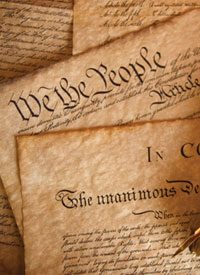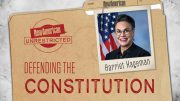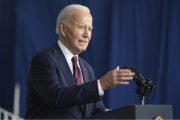
Constitutional Interpretation
Of all the confusion and numerous misconceptions surrounding the Constitution, none is more prevalent than the notion that the Supreme Court is the ultimate arbiter of the Constitution. Referring to the Supreme Court as the ultimate arbiter means that they get the final say on what the Constitution means and, in addition, can reinterpret it on a whim. This couldn’t be further from what the original Framers and ratifiers of the Constitution had in mind. One of the first cases read by students of constitutional law is Marbury v. Madison. Without delving into all the details surrounding Marbury, students are taught that the court opinion by Chief Justice John Marshall establishes the Supreme Court as the final arbiter of the Constitution. This role, as it is commonly taught, means the Supreme Court can say what is and what is not constitutional, even going so far as to create new legal doctrines independent of the founding period.
Constitutional scholar William J. Watkins disagrees that this is what Marbury actually said: “Today, Marbury is cited for the proposition that the Supreme Court is the final arbiter of the Constitution. This interpretation divorces Marbury from its historical roots and grossly overstates the holding of that case.” Watkins distinguishes between true judicial review as envisioned by the Founders and what we now have. He refers to the latter as judicial supremacy; some other fierce critics have referred to it as judicial dictatorship. He makes a strong argument that judicial supremacy harkens back to the pre-Revolutionary status of the unchecked British Parliament, which the Founders rebelled against: “Unlike judicial review, judicial supremacy is … a regression to an older theory of sovereignty that existed prior to the American Revolution. Judicial supremacy places the Supreme Court in the position of Parliament. Having the final word in constitutional interpretation, the court can make or unmake any law as it sees fit. Other than a very difficult amendment process, the people can do nothing to control it. Judicial supremacy actually poses a greater danger to the people than a system of parliamentary sovereignty. At least members of the House of Commons are subject to popular elections. The Supreme Court is not subject to this check nor are most of the courts of last resort on the state level.”
Watkins’ assertion of true judicial review squares with an originalist approach to the Constitution. In The Federalist, No. 78, Alexander Hamilton vowed to the ratifiers that the judiciary is “is beyond comparison the weakest of the three departments of power.” What is the proper role of the judiciary? Hamilton explained that its ability was limited to only preventing the Congress from overstepping their limits by legislating in an area outside of their constitutional authorization.
This understanding of judicial review is buttressed by the prominent law professor of the late 19th century, James Bradley Thayer. “We are much too apt to think of the judicial power of disregarding the acts of the other departments as our only protection against oppression and ruin. But it is remarkable how small a part this played in any of the debates. The chief protections were a wide suffrage, short terms of office, a double legislative chamber, and the so-called executive veto. There was, in general, the greatest unwillingness to give the judiciary any share in the law-making power.”
Even Chief Justice John Marshall himself, the man credited with establishing expansive judicial review, understood the judiciary’s limitations on actually creating new legal doctrines. Present Supreme Court Justice Antonin Scalia recalls that Marshall expressed that the “principles of the Constitution are deemed fundamental and permanent and, except for formal amendments, unchangeable.”
Marshall personally declared, “The difference between the departments undoubtedly is, that the legislature makes, the executive executes, and the judiciary construes the law.”
Following Unconstitutional Precedent
So how did the Supreme Court broaden its jurisdiction and, in effect, re-write the Constitution? The answer to that question lies in the concept of stare decisis (Latin for “to stand by the things decided”), which is the legal doctrine of precedent. Black’s Law Dictionary defines it as when it is “necessary for a court to follow earlier judicial decisions when the same points arise again in litigation.” Once the concept of judicial review was established, it led to a series of cases where the court began to rely on earlier cases as sources for decisions instead of the Constitution itself. In his book We Hold These Truths, the late Congressman (and former chairman of the John Birch Society) Larry McDonald summed up the history of how the Supreme Court moved further and further away from the Constitution: “From the first cases they heard, Justices of the Supreme Court have said too much in their majority decisions and dissenting opinions. They seem to pride themselves on their literary style. Instead of stating their decision in the case at hand and citing authorities used, they tend to philosophize and explain, and thus fill the record with language, which later justices expound and expand.”
McDonald distinguished between earlier court cases where the justices, although verbose, still referred to original sources of the founding period, and later cases where justices started referring only to decisions of prior courts. Some of these cases involved justices re-defining terms or words in the Constitution beyond their original meanings and lessening the restrictions on government power. “By making careless definitions and by implying meanings instead of stating them expressly, previous courts had planted seeds for subsequent court perversions of the Constitution.” In addition, justices began using brand new sources to justify their holdings. “Instead [of the Constitution], they cited and expatiated on outside commentaries about social conditions, economics and politics.”
Law Professor Richard A. Epstein, author of How Progressives Rewrote the Constitution, had some harsh criticism for the path the court used to break free from the chains of the Constitution. “They saw in constitutional interpretation the opportunity to rewrite a Constitution that showed at every turn the influence of John Locke and James Madison into a different Constitution, which reflected the wisdom of the leading intellectual reformers of their own time.”
Originalism
Defining the Constitution based on the original understanding, meaning, and intent is referred to as originalism, and supporters of this are referred to as originalists, or as they are more popularly known, constitutionalists. Constitutionalism is extremely important because it provides insight into the Constitution’s true purpose regardless of an individual’s personal preference. The Constitution means what it meant at the time of ratification and the same holds true with regard to the amendments at the time of their adoption. This objective method removes the subjective ability of activists to insert their political beliefs in place of the Constitution.
The originalist method of constitutional interpretation was commonplace in America for much of the early history of our Republic. Supreme Court Justice Joseph Story described this method when he said, “The first and fundamental rule in the interpretation of all instruments is, to construe them according to the sense of the terms, and intentions of the parties.” Thomas Jefferson, writing to his friend James Madison, clarified the simple process: “Construe the Constitution according to the plain and ordinary meaning of its language, to the common intendment of the time and those who framed it.”
Madison, widely regarded as the “Father of the Constitution,” echoed these sentiments: “I entirely concur in the propriety of resorting to the sense in which the Constitution was accepted and ratified by the nation. In that sense alone it is the legitimate Constitution. And if that be not the guide in expounding it, there can be no security for a consistent and stable, more than for a faithful exercise of its powers.”
This method of originalist analysis of the Constitution is the same as that used by lawyers in the founding generation. University of Montana Law Professor Robert G. Natelson elucidates the steps in this analysis. The constitutional researcher “seeks and applies the ratifiers’ subjective understanding of the constitutional language, to the extent that subjective understanding is recoverable. If it is not recoverable, then one applies the original public meaning of the words. Note that the subjective understanding sought is that of the ratifiers rather than the drafters, for it was the ratifiers who transformed the Constitution from a proposal into basic law.”
Non-originalism Is Judicial Activism
On the other side of the debate, there are numerous proponents of “a living, breathing” Constitution who assert that the document must “change” with the times. This approach allows the researcher or interpreter, perhaps more accurately referred to as a “re-writer,” to go literally beyond the Constitution to decide cases and create new law. Prominent legal scholar John Hart Ely advocated strongly for this approach. He felt “that courts should go beyond that set of references and enforce norms that cannot be discovered within the four corners of the document.”
The technique of judges drastically re-interpreting the Constitution without regard to its founding period has come to be known as “judicial activism.” This approach is widely taught in law schools and promoted by the establishment elite as an enlightened improvement from the old “horse and buggy” approach of constitutionalists.
Conservative legal scholar and one-time Supreme Court nominee Robert Bork has his own theory on why this approach is popular among the establishment elite: “An elite moral or political view may never be able to win an election or command the votes of a majority of a legislature, but it may nonetheless influence judges and gain the force of law in that way. That is the reason judicial activism is extremely popular with certain elites and why they encourage judges to think it the highest aspect of their calling…. The judge is free to reflect the ‘better’ opinion [that is, the judge’s opinion] because he need not stand for reelection and because he can deflect the majority’s anger by claiming merely to have been enforcing the Constitution. Constitutional jurisprudence is mysterious terrain for most people, who have more pressing things to think about. And a very handy fact that is for revisionists.”
In addition to Bork’s reasoning, judicial activism is also a great way for the federal government to expand its power in spite of constitutional limitations without having to follow the formal amendment process as described in Article V. The political elites in charge of our government can ignore Article V and simply have political appointees rewrite the Constitution by judicial fiat while telling the electorate the government’s actions are constitutional.
A well-known believer of this approach is President Barack Obama. In a 2001 interview with a local radio station, Obama faulted the Supreme Court headed by Earl Warren, one of the most radically liberal Chief Justices ever, for not going far enough in reinterpreting the U.S. Constitution. Obama complained the activist Warren Court “didn’t break free from the essential constraints that were placed by the Founding Fathers in the Constitution, at least as it’s been interpreted, and the Warren Court interpreted in the same way, that generally the Constitution is a charter of negative liberties. Says what the states can’t do to you. Says what the federal government can’t do to you, but doesn’t say what the federal government or state government must do on your behalf.” Based on the president’s statements, it would appear that Obama’s ideal Supreme Court justice would be one willing to look past the Constitution in order to create the law the president desires.
Such a position conflicts with the entire reason for having a written Constitution. If the document can simply be modified at will, then why even record it in the first place? Constitutional scholar Raoul Berger stirred quite a controversy when he challenged the liberal status quo at the height of judicial activism with his academic research into the Constitution: “The issue is who may revise the Constitution — the people by amendment or the judges, who are unelected, unaccountable and virtually irremovable…. Against this, the activists argue that over the years words change their meanings. But that does not authorize us to saddle the Founders with our meanings…. Their defense of the Justices’ substitution of their own meaning for that of the Founders displaces the choices made by the people in the conventions that ratified the Constitution, and it violates the basic principle of government by consent of the governed.”
Indeed, the entire notion of an unwritten Constitution, which could easily change based on the desires of the political elite, was exactly what the framers had sought to get away from. They believed that part of the reason the British constitution was a failure was because it was unwritten. For this and other reasons, they desperately wanted to permanently fix the terms by which the people were to be governed. If the government can just reinterpret the fundamental law of the land as they see fit, then what limits are there on that government? The result is a completely unrestrained government that is dangerous to the liberty of the citizenry. The Founders had learned this painful lesson all too well under the tyranny of King George III.
The Future of Constitutionalism
The Constitution is the rule book by which our national government should play. Once that very same government starts making the rules up as they go along, we run the risk of descending into the same type of tyranny that our patriotic Revolutionary Founding Fathers rebelled against. It is human nature to be tempted to “read” one’s personal feelings into the Constitution. Doing this allows someone to declare anything they like as constitutional and anything they dislike as unconstitutional. That approach of substituting one’s personal beliefs for the supreme law of the land is in direct conflict with our nation’s founding. It’s bad enough when individuals do it in the course of their personal lives, but absolutely unforgivable when our public officials do it in their representative capacity.
So what should be done? Can we formulate an effective strategy to restore constitutional governance? Boston University Law Professor Gary S. Lawson definitely thinks so. His feelings are that it will take time and a lot of work if enough Americans work together, but that it’s definitely obtainable:
Any strategy must be long-term, and it requires three critical elements…. The first element is to de-legitimize precedent. As long as precedent is considered a conversation-stopper, all is lost, because there are strong precedents for unraveling each and every feature of the Constitution that stands in the way of the administrative state…. The second element is to continue developing the case for the correct meaning of the Constitution…. The third element is the most critical of all.… There just are not a great many people who care very much about the Constitution. Politicians, in turn, will not care about the Constitution until and unless enough people care about it to make a difference. Right now, the Constitution has no constituency. It needs one large enough to compete in the political marketplace with other interest groups.
If our country is to ever return to its limited-government roots, it will be because the people demand that public officials strictly adhere to their oath to abide by the Constitution. Concerned citizens need not come up with new ways to accomplish this, though. Our Founders left us a very clear and lucid way to restrain the central government: the U.S. Constitution. Lawson’s approach wisely cuts across the political spectrum to join disparate groups with a shared aim. Traditional conservatives, libertarians, and anti-globalists of all types can unite in the common goal of returning the federal government to its original constitutional role.



